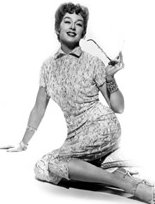
"I never said, 'I want to be alone.' I only said, 'I want to be left alone.' There is a whole world of difference."
With her breathtaking beauty and enigmatic persona, Greta Garbo remains the ultimate Hollywood icon. As MGM’s highest-paid star, Garbo had approval of story, costar, director and cinematographer, often closing the set to visitors and crewmembers. For fifteen years, Garbo wielded power that few could match—yet she was often at odds with the system that made her a phenomenon. She was famous for her reclusive lifestyle, which became part of the Garbo mystique. Except at the very beginning of her career, she granted no interviews, signed no autographs, attended no premieres, and answered no fan mail.
While Greta Garbo made over 25 films in Hollywood, many of them are unfamiliar to contemporary audiences due to a prejudice against silent films. But these are the films that made her famous and established her legendary association with John Gilbert.
THE TORRENT (1926) Garbo’s first film in the U.S. Directed by Monta Bell, Garbo plays Leonara, a Spanish peasant girl who is sent to Paris and becomes an opera singer.
FLESH AND THE DEVIL (1926) Directed by Clarence Brown and costarring John Gilbert. This marked Garbo’s first collaboration with director Clarence Brown as well as her first film with John Gilbert. This story of fallen love broke box office records across the country and established Garbo and Gilbert as great lovers of the silver screen.
LOVE (1927) Directed by Edmund Goldberg. The tagline for this film read simply, “Garbo and Gilbert in Love.” Garbo’s first version of Tolstoy’s Anna Karenina, made with two endings, happy and sad.
THE KISS (1929) Directed by Jacques Feyder. This was the last film MGM made without dialogue (it used a soundtrack with music and sound-effects only), and marked the end of an era. A courtroom drama in which Garbo is tried for the murder of her jealous husband.
If you can’t sit through silent films, Garbo successfully transitioned into talkies to make the following films:
ANNA CHRISTIE (1930) Directed by Clarence Brown. Garbo Talks! Garbo’s low, husky voice was heard on screen for the first time in Eugene O'Neill's Anna Christie. The movie was a huge success, but Garbo personally hated her performance. Audiences waited 16 minutes for her entrance to hear her say, “Gimme a whiskey, ginger ale on the side. And don’t be stingy, baby.”
ROMANCE (1930) Directed by Clarence Brown. Garbo plays prima donna Rita Cavallini in this period drama. She was nominated for the Academy Award for Best Actress for this film as well as Anna Christie, but lost to Norma Shearer in The Divorcee.
QUEEN CHRISTINA (1934) Directed by Rouben Mamoulian. A historical drama that takes considerable liberty with fact. Christina inherits the Swedish throne in 1632 at the age of 6 after her father’s death on the battlefield. When she refuses to marry and produce an heir, she is forced to abdicate at the age of 28. This film tones down Christina’s lesbianism, but portrays her as a progressive woman of intelligence and sophistication who could not bow to the limitations placed on women of her time. One of my favorites.
CAMILLE (1936) Directed by George Cukor. Her performance as the doomed courtesan in Camille was called the finest ever recorded on film. Garbo was nominated for Academy Award for Best Actress again.
NINOTCHKA (1939) Directed by Ernst Lubitsch. Garbo in her first comedic role, Ninotchka was one of her favorite films and for which she was nominated for the Academy Award for Best Actress again. Garbo plays a Soviet agent in Paris who falls in love with a French nobleman. Another favorite.
"Her instinct, her mastery over the machine, was pure witchcraft. I cannot analyze this woman's acting. I only know that no one else so effectively worked in front of a camera." —Bette Davis





